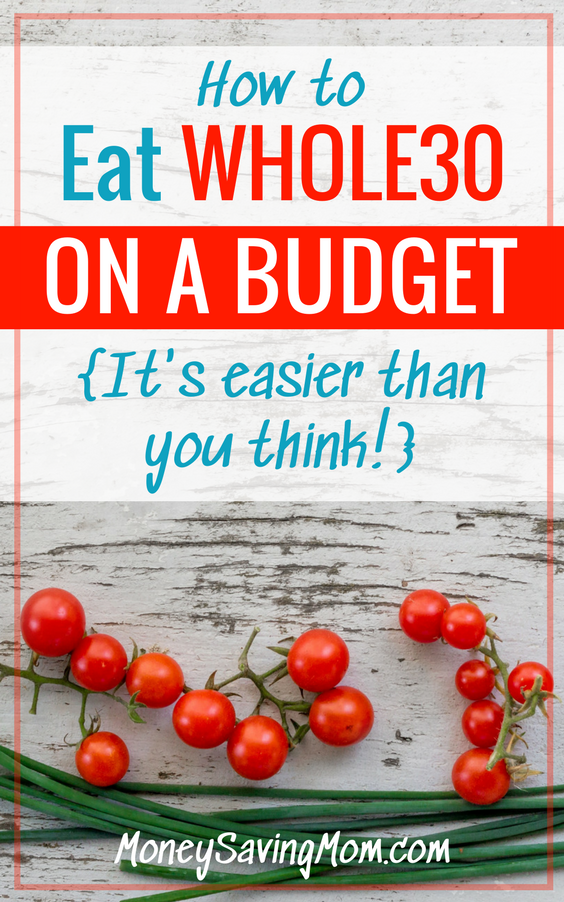
Guest post from Sara of SK Bell:
If you hang around the internet much, it seems that people everywhere are attempting the a Whole30 challenge and seeing amazing results. Clearer skin, better sleep, reversal of serious health issues, eliminating expensive medications… and in many cases, impressive weight loss.
Whole30 has so many amazing benefits… why wouldn’t you want to try it? (Aside from the whole giving-up-your-favorite-junk-food thing!)
Well, it’s expensive. Like, really expensive.
I’m currently enjoying my third Whole30 attempt (the first two were failures, but we don’t have to talk about that…) and I feel like I’ve got a pretty good handle on the financial side of things this time around. Here are a few of my tips to do a Whole30 on a budget:
1. Plan ahead.
This one speaks for itself but is incredibly important. Go to the store knowing what you’re going to prepare each night.
2. Price shop.
With three children under four years old, hitting more than one grocery store is a little bit frustrating. I’ve given this up and picked it back up more times than I can count!
Sometimes the time isn’t worth it to me, but I have to admit that buying my groceries from two or three different stores tends to make a world of difference price-wise.
When I opt not to shop at more than one store, I try to keep my grocery list somewhat flexible so I can price shop inside the store. If a cut of stew meat on clearance costs less than the ground beef I had planned to buy, I’m probably the lady in the corner re-writing a portion of my list while sighing “no, we’re not buying that today. Please put that back.”
3. Remember the Dirty Dozen.
In a perfect world, your Whole30 would include all-organic, cage-free, free-range, grass-fed, and maybe even homegrown. I say do as much of that as you can… but don’t beat yourself up about what you can’t!
Keep the Dirty Dozen and Clean 15 lists in mind when you’re buying your produce. Remember that conventional produce is always healthier than organic junk food.
4. Use frozen foods.
Frozen fruits and veggies can sometimes be far less expensive than their fresh versions. Of course, you’ll want fresh for some recipes… but certain meals work great with frozen produce.
I love making a Whole30-friendly Zuppa Toscana, for example, with frozen spinach or kale instead of fresh. I prefer that texture.
5. Stock up on eggs.
Eggs are without a doubt your least expensive protein source during a Whole30. Hardboiled! Deviled, with paleo mayo! Scrambled! Fried! Poached! Overeasy! Omelets! Frittatas! Quiches!
I think if you switch them up enough, you’re less likely to get so sick of them.
6. Buy your meats in bulk.
Whether you’re buying from the butcher, from the all-organic health food store, or from your regular grocery store: figure out the most inexpensive way to get the meat you’re looking for!
7. Don’t assume coupons are out.
For starters, you can always use your coupons to buy the non-food items on your list — soap, toothpaste, laundry detergent — but there are occasionally coupons for Whole30-friendly items if you look for them.
Some paleo blogs have offers for free Primal Mayo and coconut oils on their sidebars. Mambo Sprouts occasionally has coupons you can use, and loading coupons to your online accounts at Natural Grocers and whatever Kroger store is in your area can also sometimes result in a discounted item or two.
8. DIY.
I’m kind of obsessed with cauliflower “rice” during a Whole30. Even my husband, who is not a big veggie eater, loves cauli-rice. Every time he heads into a town with a Trader Joe’s, I have him pick up a bag or two of their pre-riced cauliflower to make my life easier. Once in awhile it’s on a great sale, but most of the time it would have been cheaper to buy a head of cauliflower elsewhere and make it myself.
If you have a food processor, cauli-rice is available to you with just a few pulses. If you don’t just use a cheese grater.
Pre-cut fruits or veggies, pre-made meatballs, and pre-made broth are other examples of things that save time but are almost always a little more expensive.
9. Make double batches.
Take a page out of the Money Saving Mom handbook and whip up some double batches with that meat you bought in bulk… or, if you’re like me, you can divide that meat up into a few different dishes and save yourself time and money, an obvious double win.
Ground beef becomes pre-made burger patties, browned meat for taco salads, and meatballs for albondigas soup or for serving with sautéed veggies.
Chicken gets divided up to serve with fajita seasonings over cauli-rice, over a salad, or cooked in coconut aminos for a stir-fry.
Ground turkey gets turned into chili, and then into Italian turkey sausage for stuffed mushrooms or that Zuppa I love so much.
If you have a friend or family member interested in doing a Whole30 alongside you, talk about swapping meals! Each of you can make a double batch of something and trade.
I haven’t even finished a Whole30 yet and I’ve already seen amazing results. If you’ve been toying with the idea, please, GO FOR IT! You will be so thankful you did! I think you can do it fairly inexpensively if you plan ahead and follow the suggestions above. Good luck!
SK Bell is a Jesus-loving wife, mama, author, and chocolate-addicted traveler. You can find her blog at www.skbellblog.blogspot.com and you can find her Whole30 successes, failures, and recipes using the Instagram hashtag #skbellwhole30
Do you want to take better control of your grocery budget? If so, you’ll want to read my newest eBook, 5 Days to a Better Grocery Budget!
This eBook will give you all the tips, tricks, and practical advice you need to create a grocery budget tailored to your family’s needs that you can actually STICK to (because that’s the key!)
In this eBook, you’ll learn:
- How to create a grocery budget that fits your family’s needs and your finances!
- New systems to help you keep track of what you spend at the store!
- How to actually stick with your new budget and save money for years to come!
- Ways to save up to $50 off your grocery bill THIS WEEK by using the 10 simple strategies outlined in this eBook!
Read to get started? Just use the form below to sign up!
[better_budget_form]


I have read your wonderful article and without a doubt, I will try it. Thank you for sharing this idea, it really is very helpful. I believe that we should always treat ourselves out, but sometimes we should think twice if it’s going to be worth it. This article is something I would share to my friends so they can also follow these steps.
Besides coupons be sure to check out using the Ibotta app. It almost always has fresh fruit and veggies on rebates and recently has had the veggie mayos. It varies from store to store I noticed so be sure to look at different stores on the app.
Definitely a great tip! -Meg, MSM Team
You can now purchase riced cauliflower in both the fresh produce section {with the already prepared veggies and bagged lettuce} and freezer section of WalMart.
Thanks for sharing! -Meg, MSM Team
Thanks, this is such great news to me!
Although I don’t have a Walmart in my town either 😐
We are currently on our third Whole 30 and I can guarantee that it is worth it! We definitely raise our food budget when we do a whole 30 but it is on purpose and planned for so that we can experiment and treat ourselves to things like steak and salmon more often. If you haven’t yet Vitacost and Thrive are great ways to get whole 30 specialty items for cheap! I just made a video about the things you can get on Thrive for your whole 30. https://www.youtube.com/watch?v=AlRUcH0ypVk
I also chronicled my first whole on my blog, it was a great way to stay accountable. Way to go, it is a big change but so great!
Thanks so much for sharing about your experience! -Meg, MSM Team
While you may not want to use it completely, my husband and I also took our separate budget for eating out and added that to our grocery budget for our Whole 30. We only went out to eat once or twice, since there weren’t a lot of easily compliant options, so we were able to use most of that money for food we made at home.
Great idea! -Meg, MSM Team